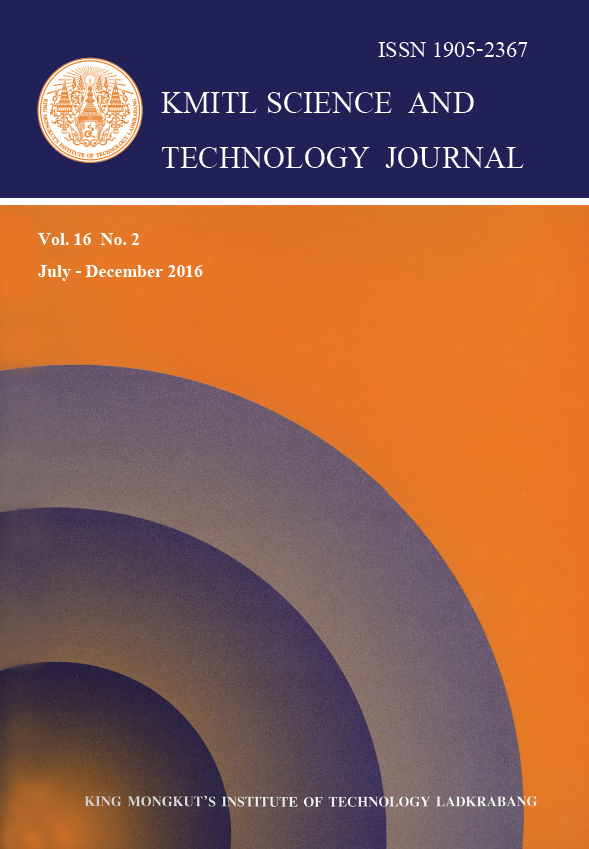Supplements of Saccharomyces cerevesiae on Production Performance of Lactating Cows
Main Article Content
Abstract
This study was conducted to investigate three levels of yeast (Saccharomyces cerevesiae) as
supplement (0, 10 and 90 g/day) in animal feed for dairy cow consumption. Six multiparous dairy
cows were assigned in the experiment 3 3 latin square design. The results showed that, regarding
milk yield, the control group gave the lowest milk yield with significant difference from the groups
with 10 and 90 g/day of yeast (P<0.05). The supplement group with 90 g/day of yeast gave the
highest milk yield and was not different from the group with 10 g/day of yeast (P>0.05). In terms of
milk compositions, the control group had the lowest fat, protein and solid not fat. However, the total
solid was not different from the group with 90 g/day of yeast (P>0.05). The group with 10 g/day of
yeast gave the highest fat, protein, solid not fat and total solid that were not different from the group
with 90 g/day of yeast (P>0.05). Regarding somatic cell count, the control group gave the highest
somatic cell count which was different from the groups with 10 and 90 g/day of yeast (P<0.05).
However, somatic cell count of the groups with 10 and 90 g/day of yeast were not different
(P>0.05). For dry matter intake, the control group gave the highest level for pangola grass,
concentrate and total intake and was different from the groups with 10 and 90 g/day of yeast
(P<0.05). For the incomes of raw milk, the groups with 90 g/day of yeast gave the highest income
of 200.88 bath/day followed by the group with 10 g/day of yeast and the control group of 199.94
baht/day and 192.02 bath/day, respectively. Calculation of net profit of raw milk showed that the
group with 10 g/day of yeast had the highest net profit of 111.68 bath/day followed by the control
group (100.80 baht/day) and the lowest net profit was from the group with 90 g/day of yeast at
94.72 bath/day.
Keywords: Saccharomyces cerevesiae, milk yield, animal feed, cow
*Corresponding author: Tel.: +66 25791120 Fax: +66 25791120
E-mail: fagrptk@ku.ac.th
Article Details
Copyright Transfer Statement
The copyright of this article is transferred to Current Applied Science and Technology journal with effect if and when the article is accepted for publication. The copyright transfer covers the exclusive right to reproduce and distribute the article, including reprints, translations, photographic reproductions, electronic form (offline, online) or any other reproductions of similar nature.
The author warrants that this contribution is original and that he/she has full power to make this grant. The author signs for and accepts responsibility for releasing this material on behalf of any and all co-authors.
Here is the link for download: Copyright transfer form.pdf
References
[2] Church, D.C., 1979. Digestive Physiology and Nutrition of Ruminants. Vol.2. O B Book, Inc., Portland, Oregon.
[3] Wallage, R.J. and Newbold, C.J., 1992. Probiotics for ruminants. pp. 317–344. In. Fuller, R ed. Probiotics The Scientific Basis, Chapman Hall Press, London.
[4] Van Soest, P.J. Robertson, J.B. and Lewis, B.A., 1991. Method for dietary fiber, neutral detergent and non starch polysaccharides in relation to animal nutrition. J. Dairy. Sci, 74, 3583–3597.
[5] Dawson, K.A., 2005. The use of complementary tool, monenbsin and YEA-SACC1026 to synergistically modify ruminal functions and improve the performance of dairy cattle, In: T.P. Lyons and K.A. Jacques, eds. Nutritional Biotechnology in the Feed and Food Industries Proceeding of Alltech ’s 21st Annual Symposium. Nottingham University Press, Nottingham.
[6] Zaworski, E.M., Shriver-Munsch, C.M., Fadden, N.A., Sanchez, W.K., Yoon, I. and Bobe, G., 2014. Effect of feeding various dosages of Saccharomyces cerevesiae fermentation in transition dairy cows. J. Dairy. Sci., 97, 3081–3098.
[7] NRC, 2001. Nutrient Requirements of Dairy Cattle. National Academy Press, Washington D.C.
[8] A.O.A.C, 1984. Official Methods of Analysis the Association of Official Analytical Chemists. 14th ed. William Byrd Press, Richmond, Verginia.
[9] Van Soest, P.J., 1994. Nutritional Ecology of The Ruminant. Cornell University Press, New York.
[10] SAS, 2000. Statistical Analysis System. V. 8.1. SAS Institute, Inc., Cary, North Carolina.
[11] Animal nutrition division, 2008. Pangola Grass.[online] Available at: https://www.dld.go.th/ nutrition/Nutrition Knowlage/nutrition1.htm.
[12] Tudsri, S., 2004. Tropical Pasture. Kasetsart University.
[13] Mediterranean Italian Breed Centre, 2006. The effect of YEA-SACC1026 on performance when added to the diet of lactating buffalo. Poster presented at Alltech ’s 22nd Annual Symposium, Apirl 24–26, 2006. Lexinton, Kentucky.
[14] Kung, J.R., Kreck, E.M., Tung, R.S., Hession, A.O., Sheperd, A.C., Cohen, M.A., Swain, H.E. and Leedle, J.A.Z., 1997. Effect of a live yeast culture and enzymes on in vitro ruminal fermentation and milk production of dairy cows. J. Dairy Sci., 80, 2045–2051.
[15] Philpot, E.N. and Nickerson, S.C., 1999. Mastitis: Counter Attack. Publish by Westfalia Surge LTC., Illinois.
[16] Lita, Z.A., Mohammed, N., Yasui, T., Kurokawa, Y., Kanda, S. and Itabashi, H., 2004. Effect of two strain of Saccharomyces cerevesiae live cells on mixed ruminal microorganism fermentation in vitro. J. Anim. Sci., 73, 2971–2995.
[17] Shultz, T.A., 1984. Weather and shade effects on cow coral a activity. J. Dairy. Sci., 670, 868–876.
[18] Bodero, J. and Reason, G.K., 1988. The effect of temperature and humidity on dairy milk production and milk composition for four breeds of dairy cattle at Darwin, Queenland. Aust. J. Agri. Res., 45,229–237.
[19] Ray, D.E., Halbach, T.J. and Armstrong, D.V., 1992. Season and lactation number effects on milk production of dairy cattle in Arizona. J. Dairy. Sci., 54, 2976–2983.
[20] Klottrub, N., 2006. Response to YEA-SACC1026 in corn silages–based diets. Animal Nutrition, Alltech, Denmark.
[21] Sinckair, L.A., Ranson, K., Ames, S. and Wilde, D., 2006. The effect of including YEA-SACC1026 yeast culture on the intake and performance of high yielding dairy cows fed a diet high in starch. Poster presented at Alltech ’s 22nd Annual Symposium, Apirl 24–26, 2006. Lexinton, Kentucky.


